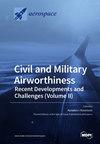使用格子波尔兹曼法全面研究电控转子的空气动力特性
IF 2.2
3区 工程技术
Q2 ENGINEERING, AEROSPACE
引用次数: 0
摘要
电控转子(ECR)是一种通过尾翼襟翼系统代替斜盘实现主控的无斜盘转子,在减振和降噪方面具有巨大潜力。本文采用网格玻尔兹曼法(LBM)这种介观数值模拟方法来研究 ECR 的气动特性。在 LBM 中,离散化的玻尔兹曼输运方程被求解以模拟流体的宏观运动,本研究采用了 D3Q27 模型。襟翼偏转对 ECR 空气动力学特性的影响可通过适当的细化壁格分辨率精确包含在内。在此基础上,采用自适应尾流细化策略来跟踪尾流的演变,并充分捕捉尾流流场中尾流结构的细节。基于这种方法,可以在 XFlow 仿真平台上建立 ECR 的气动分析模型。对气动分析模型进行了验证,结果表明 LBM 可以准确捕捉转子流场的细节,计算叶片气动载荷,并预测转子的下冲。因此,基于该模型分析了 ECR 在悬停和前进飞行条件下的气动特性,并捕捉到了襟翼偏转对尾流结构、诱导流入量和叶盘载荷的影响。结果表明,修剪旋翼所需的相对较大的襟翼偏转会在 ECR 尾流流场中造成额外的强烈襟翼尾流涡旋,而非传统旋翼尾流流场中表现出的叶尖和叶根处的集中涡流,从而显著改变圆盘诱导流入量和气动载荷的分布。本文章由计算机程序翻译,如有差异,请以英文原文为准。
A Comprehensive Study on the Aerodynamic Characteristics of Electrically Controlled Rotor Using Lattice Boltzmann Method
An electrically controlled rotor (ECR) is a kind of swashplateless rotor that implements the primary control via the trailing-edge flap system instead of a swashplate and demonstrates great potential in vibration reduction and noise alleviation. In this paper, the mesoscopic numerical simulation method known as the lattice Boltzmann method (LBM) is employed to investigate the aerodynamic characteristics of an ECR. In the LBM, the discretized Boltzmann transport equation is solved to simulate the macroscopic motion of the fluid, and the D3Q27 model is applied for this study. The effects of the flap deflection on the ECR aerodynamic characteristics can be accurately included with the appropriate refined wall lattice resolution. On this basis, the adaptive wake-refinement strategy is applied to track the evolution of the wake and adequately capture details of the wake structure in the wake flow field. Based on this method, an aerodynamic analysis model for the ECR can be established on the XFlow simulation platform. The aerodynamic analysis model is validated, and the results indicate that the LBM can accurately capture the details of the rotor flow field and calculate blade aerodynamic load, as well as predict the downwash of the rotor. Therefore, based on this model, the ECR aerodynamic characteristics under hovering and forward flight conditions are analyzed, and the effects of the flap deflection on the wake structure, induced inflow, and disc load can be captured. The results indicate that a relatively large flap deflection required to trim the rotor will cause the additional intense flap wake vortex in the ECR wake flow field, apart from the concentrated vorticity at the blade tip and root demonstrated in the conventional rotor wake flow field, and thus significantly change the distributions of the disc-induced inflow and aerodynamic load.
求助全文
通过发布文献求助,成功后即可免费获取论文全文。
去求助
来源期刊

Aerospace
ENGINEERING, AEROSPACE-
CiteScore
3.40
自引率
23.10%
发文量
661
审稿时长
6 weeks
期刊介绍:
Aerospace is a multidisciplinary science inviting submissions on, but not limited to, the following subject areas: aerodynamics computational fluid dynamics fluid-structure interaction flight mechanics plasmas research instrumentation test facilities environment material science structural analysis thermophysics and heat transfer thermal-structure interaction aeroacoustics optics electromagnetism and radar propulsion power generation and conversion fuels and propellants combustion multidisciplinary design optimization software engineering data analysis signal and image processing artificial intelligence aerospace vehicles'' operation, control and maintenance risk and reliability human factors human-automation interaction airline operations and management air traffic management airport design meteorology space exploration multi-physics interaction.
 求助内容:
求助内容: 应助结果提醒方式:
应助结果提醒方式:


